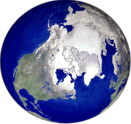

|
Variability of Arctic climate and sea ice over the past millennium: implications for ice cap mass balance |
Why the Arctic?
|
Researchers from the Geological Survey of Canada's National Glaciology Program have been obtaining and studying ice cores from the Canadian Arctic and Yukon since the 1970's. These cores have been used to investigate long term climate trends using atmospheric chemistry, stable isotopes, pollen in conjunction with other paleoenvironmental indicators from the regions (e.g. Koerner, 1977; Koerner, 1979; Koerner and Fisher, 1990; Fisher, Koerner and Reeh, 1995; Zheng et. al., 1998; Goto-Azuma and Koerner, 2001). More recently, the Arctic and Alpine Research Group of the University of Alberta has become involved in establishing a network of shallow ice cores across the Queen Elizabeth Islands. This project, which involves obtaining new cores from the Prince of Wales Icefield, setting up new facilities, training new ice core scientists, and combining skills across Canadian research institutions makes a significant contribution to Canadian ice coring research, and to enhancing the capabilities for future ice core work. The project also contributes in a broader sense to the growth of Canada's expertise in Arctic science, supplementing other recent initiatives such as the NSERC Northern Chairs, ArcticNet, and the Canadian Research Icebreaker. |


|